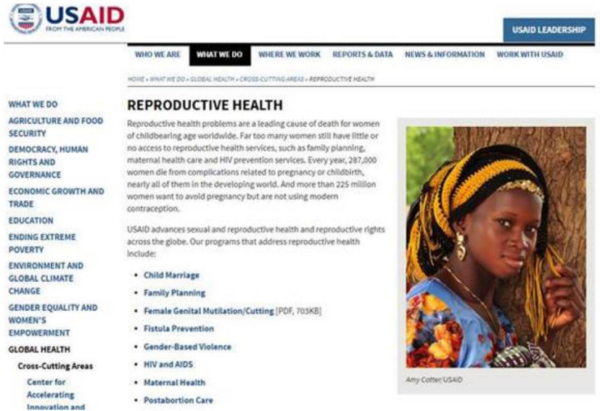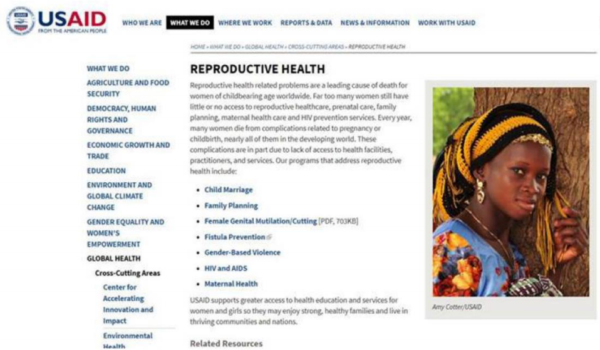In December 2017, analysts at the Centers for Disease Control and Prevention (CDC) were directed to avoid using seven words in budget documents: “evidence-based,” “science-based,” “vulnerable,” “entitlement,” “diversity,” transgender” and “fetus.” This move foreshadowed efforts to modify the language of international family planning and reproductive health (FP/RH) programs that appear to be ramping up as the Trump-Pence administration starts its second year in office.
In the domestic arena, Trump’s war on women’s words escalated from altering terminology to translating it into policy last Friday evening with the delayed issuance by the Department of Health and Human Services of the 2018 “funding opportunity announcement,” application instructions for grants under the Title X domestic family planning programs. The 60-page announcement does not contain a single mention of the words “contraceptives” or “contraceptive services”—the foundation of the nation’s federal family planning program since its creation in 1970. At the same time, the document emphasizes natural family planning (NFP) over FDA-approved contraceptive methods, making six explicit references to NFP and designating NFP as a program priority on which grant applications will be evaluated. The administration seeks to shift the focus of the Title X program from delivering high-quality, client-centered, comprehensive family planning services toward a behavior change program promoting abstinence—or as the document describes, a return to a “sexually risk-free status.”
In Washington, it is to be expected that there will be a shift in language and policy—particularly around hot-button issues like abortion and LGBTQI rights in the ongoing culture wars—depending on the party occupying the White House. Usually, the change in language manifests itself more subtly. However, what is being witnessed under the Trump-Pence administration is a wholesale attack on sound public health practice, a rejection of evidence-based policymaking, and the denigration of professional and scientific expertise through the deliberate manipulation of language to conceal the expansiveness of their plans for radical ideological realignment of the federal government’s domestic and international family planning programs.
The first public whiff of what Trump-Pence apparatchiks—now firmly ensconced inside the government—have in mind for international FP/RH came with a leaked White House Domestic Policy Council wish list for the President’s FY 2019 budget request. The memo proposed equal funding between “fertility awareness methods” and modern contraceptives such as the birth control pill, injectables, implants and IUDS. “Fertility awareness” is the newly fashionable name for what had previously been called natural family planning (NFP) or periodic abstinence, known for its lower effectiveness rate and unpopularity among women. For addressing “adolescent sexual and reproductive health,” the wish list’s prescription was fertility awareness methods only—“100% for kids, no other family planning programming for girls.”
Additional worrying signs have begun to appear with increasing frequency in the form of language used in public fora and in the FY 2019 congressional budget justification for the U.S. Agency for International Development (USAID), an aborted attempt to modify the USAID webpage describing its FP/RH activities, and last-minute censorship of content and coverage in the State Department’s forthcoming annual Country Reports of Human Rights Practices.
Beginning during the Obama administration but accelerating with the arrival of the Trump-Pence administration and their expected hostility toward international FP/RH programs, some well-meaning officials and advocates have suggested that embedding family planning and reproductive health within a more politically palatable message of improving maternal and child health (MCH) outcomes would help insulate FP/RH programs from attack and might even attract a new audience of religiously-motivated supporters. This effort has resulted in adding report language promoting “healthy timing and spacing of pregnancy” to congressional appropriations bills and to political appointees reframing family planning as a programmatic element in promoting “family health” or “ending preventable child and maternal deaths.”
Both “healthy timing and spacing of pregnancy” and “family health” misrepresent the fact that helping to save the lives of women and children has always been a core mission of the Office of Population and Reproductive Health at USAID—but it is not the only mission. If the focus were to shift entirely to the maternal and child health rationale, it would both detract from and negatively impact the broad contributions that family planning access provides around our larger development goals, including empowering women and girls, decreasing poverty, increasing economic gains and promoting sustainable development. It might also be construed to limit other FP/RH activities that USAID engages in, including programs to address adolescent sexual and reproductive health; prevent child, early and forced marriage; combat gender-based violence; encourage FP/HIV integration; prevent female genital mutilation and obstetric fistula; and to expand access to permanent or long-acting reversible contraceptive methods. These activities are equally important and distinct from planning a family, or spacing births.
The effort to subsume FP/RH under a broader MCH rubric manifested itself in documents related to the President’s FY 2019 budget request. In the global health programs section of the Congressional Budget Justification (CBJ), the Trump CBJ—like the last Obama CBJ (FY 2017)—divides the global health portfolio into three buckets:
- HIV/AIDS, including the President’s Emergency Plan for AIDS Relief, and Global Fund contributions;
- “Preventing Child and Maternal Deaths,” including MCH, FP/RH, nutrition, and malaria (President’s Malaria Initiative); and
- “Combating Infectious Disease Threats,” including tuberculosis, neglected tropical diseases, and global health security.
Interestingly, however, the Trump CBJ changes the title of the maternal and child mortality bucket from “ending preventable child and maternal deaths” to just “preventing child and maternal deaths.” A subtle word change signaling adoption of a much less ambitious objective. A side-by-side comparison of the FP/RH description in the Obama FY 2017 CBJ and Trump’s latest is perhaps more revealing. The Trump CBJ lifts from the Obama CBJ almost verbatim, except for two key deleted sentences. The first merely provided the estimated unmet need for contraception and number of unintended pregnancies annually in the developing world. The second deleted sentence reads:
Priority areas include leveraging opportunities to expand services through MCH and HIV platforms; contraceptive security; community-based approaches; expanding access to voluntary long-acting and permanent contraceptive methods; promoting healthy birth spacing; and focusing on cross-cutting issues of gender, youth, and equity.
The latter deletion is more telling and highlights some of the potential problems of a solely MCH-centric rationale for family planning.
Regardless of the verbiage in the CBJ, the elements of the U.S. government’s investments are clearly defined in law and policy, including statutory language in appropriations legislation delineating the sector line-items within the global health account and in the Bush-era Foreign Assistance Standardized Program Structure used in specifying the health programs to which the expanded Trump Global Gag Rule applies.
In an until-now unreported episode, forces unknown sought to redefine the language describing the U.S. government’s work in reproductive health on the USAID website by modifying the global health web page about two weeks ago.
Here is a screenshot of the original version of the website:


Here is the screenshot of the unexpected modification:


Most noteworthy are the deletion of the bullet on post-abortion care programs, which linked to an external website of a USAID-funded project; removal of statistics on unmet need for contraception and maternal mortality; and perhaps least surprising, striking the statement that “USAID advances sexual and reproductive health and reproductive rights across the globe.” These language changes are consistent with the widely-held suspicion that references to rights-based approaches to FP/RH and abortion (even presenting factual information that access to and use of contraception reduces the incidence of abortion) are likely to be forbidden, and that discussion of adolescent sexuality will be carefully scrutinized during a Trump-Pence administration. The commissars are now in place in departments and agencies across the federal government.
Fortunately, in this instance, eagle-eyed FP/RH advocates noticed the changes to the website and alerted USAID staff of the concerning deletions, and the webpage content was restored to its original form—at least for the time being.
Unfortunately, the eleventh-hour decision by an unnamed State Department official in Secretary Tillerson’s office to order striking descriptions of the full range of human rights abuses and violations experienced by women, girls, LGBTQI people, and other marginalized communities around the world from its annual Human Rights Report is unlikely to be reversed. This despite the fact that more than 150 human rights, health and development organizations sent a letter to Secretary Tillerson on Monday condemning the directive to edit the report—just days before the statutory deadline of February 25 for delivery to Congress.
POLITICO, which originally broke the story, reported that State Department staff were told to go back into the report—which was ready to go to press—and edit to limit discussion of women’s reproductive rights and discrimination. According to Politico’s reporting, which State Department spokeswoman Heather Nauert has disputed, the “directive calls for stripping passages that describe societal views on family planning, including how much access women have to contraceptives and abortion.” A subsection of the report entitled “Reproductive Rights” is expected to be renamed “Coercion in Population Control.” Although unsurprising that an administration that has already taken extreme measures to diminish access to contraception and reproductive health care for women and girls is now turning a blind eye to these issues as central human rights concerns of the U.S. government, it is nevertheless deeply alarming.
The attempts by the Trump-Pence administration to reposition family planning solely as a health intervention, to modify agency webpages, and to redefine whether assaults on the rights of women and girls are violations of their human dignity absolutely require ongoing vigilance and opposition from supporters of sexual and reproductive health and rights and the rights of women and girls and LGBTQI persons. While nowhere as aggressive as the assaults that have taken place domestically, those efforts seeking to pervert FP/RH language and policy can be expected to accelerate dramatically in the international arena.